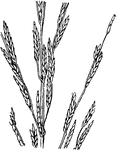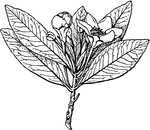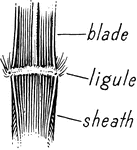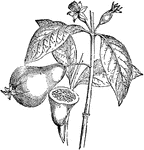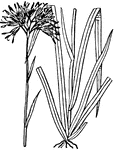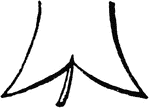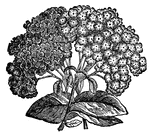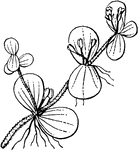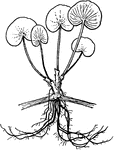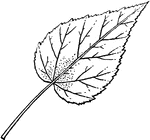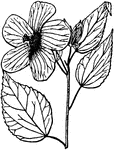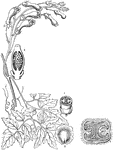
Glory Vine
"Eccremocarpus scaber. 1. cross section of its ovary; 2. longitudinal section of it; 3. seed." -Lindley,…
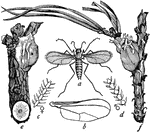
Resin Gnat
"Resin-gnat (Diplosis resinicola). a, adult female; b, wing of same; c, cross-section of antenna…
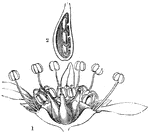
Goat's Beard
"1. flower of Spiraea Aruncus cut open; 2. a section of one of its carpels." -Lindley, 1853

Pteris Grandifolia
A large-fronded fern with straw-colored leaves. It is commonly found in tropical America.

Grapefruit Leaf
The leaf of the Grapefruit tree (Citrus decumana) in the Rutaceae family of rues or citrus.

Common Grapevine
"Vitis vinifera. 1. a flower; 2. the same casting its petals; 3. the pistil and stamens; 4. a section…

Grass Flower
"Graminae. Flower of a Grass, the glumes are removed. GRAMINAE. In botany, the largest order among endogenous…

Grass Flower
"Graminae. Flower of a Grass. GRAMINAE. In botany, the largest order among endogenous plants except…

Grass of Parnassus
A grass of Parnassus is any member of the genus Parnassia, of the Saxifrage family, growing in damp…

Gratiola
Leaves small, mostly under 3cm long; usually with black dots visible with a lens covering them.

Greasewood
"Greasewood (Sarcobatus vermiculatus). 1, with female flowers; 2, branch with fruits; a, a female flower;…

Branch of Grey Alder
Also known as Alnus tenuifolia. The branch of a Grey Alder tree, native across the cooler parts of the…

Ground Ivy
Ground Ivy (Glecoma hederacea) is a common European labiate hedgerow plant, with trailing stems, kidney-shaped,…

Ground Pine
"1. Spore-case of Lycopodium denticulatum opened; 2. antheridium; 3. spore." -Lindley, 1853
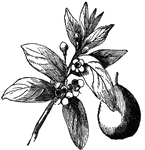
Guava
Guava (Psidium guayava) is a low-growing West Indian tree belonging to the family Myrtaceæ. It bears…

Guelder Rose
Also known as the Snowball Tree, the Guelder Rose is a cultivated form of the genus Viburnum, especially…

Gum Arabic Tree
"Acacia Verek. 1. a flower magnified; 2. the pistil; 3. a section of the same; 4. half a seed." -Lindley,…
Gynandropsis
"Flower of Gynandropsis. a, gynophore. GYNOPHORE. In botany, an elongation or internode of the receptacle…
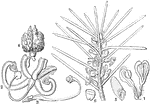
Silky Hakea
"Hakea acicularis. 1. a couple of flowers; 2. a flower magnified; 3. the pistil; 4. a fruit; 5. a seed;…

Hawthorn Blossom
Hawthorn-blossom in section; parts adnate to whole face of ovary. and with each other beyond; another…
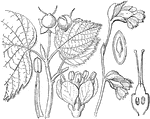
Winter Hazel
"Corylopsis. 1. flowers; 2. branch in fruit; 3. a flower separate; 4. a stamen; 5. a perpendicular section…

Heath
"Dracophyllum scoparium. 1. a sepal; 2. a flower with its bract; 3. section of a seed-vessel." -Lindley,…
Common Heath
The flowering branch of the Common Heath (Epacris impressa), a plant in the Ericaceae family of heaths.

Common Heath
The flower of the Common Heath (Epacris impressa), a plant in the Ericaceae family of heaths.
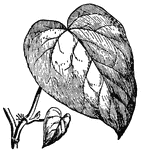
Hedera colchica
Hedera (English name ivy, plural ivies) is a genus of 15 species of climbing or ground-creeping evergreen…
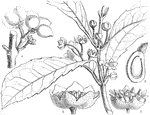
Hedycarya
"Hedycarya dentata. 1. male flower; 2. female ditto; 3. section of carpel; 4. ripe fruit." -Lindley,…
Heliconia
"Part of the inflorescence of Heliconia angustifolia; a, stamens and pistil, the surrounding parts being…
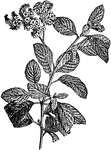
Heliotropium
The heliotropes (Heliotropium) is a genus of plants in the family Boraginaceae with 250 to 300 species.…
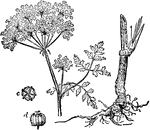
Northern Water Hemlock
Northern Water Hemlock is a species of Cicuta, native to northern and central Europe, northern Asia…

Poisonous Hemlock
Hemlock is a genus of poisonous plants. It has a tall, hollow stem and white flowers.

Hemp Plant
"Hemp adapts itself to diversities of climate, and is cultivated equally under the burning sun of the…

Polypodium Heracleum
A stout fern with light brown scales. The fronds of this fern range between 3 and 6 feet in length,…
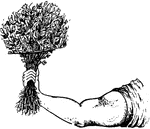
Human Arm Reaching for Herb Medicine
The representation of an outstretched human arm the hand of which holds a bunch of herbs. Herbs are…
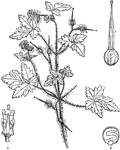
Herb Robert
"Geranium Robertianum. 1. its stamens; 2. its ovary; 3. a section of its seed." -Lindley, 1853
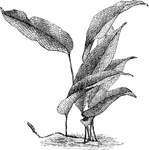
Polypodium Lingua Heteractis
This fern has broader, oblong fronds in comparison to the Polypodium lingua, whose fronds are between…

Heteranthera
Leaves without midribs evident when examined against transmitted light; flowers yellow.

Heterostemma
"4. flower of Heterostemma acuminatum; 5. one of its anthers; 6. its pollen masses." -Lindley, 1853

Hibiscus pollen
Magnified pollen of Hibiscus and other Mallow plants, beset with prickly projections.

